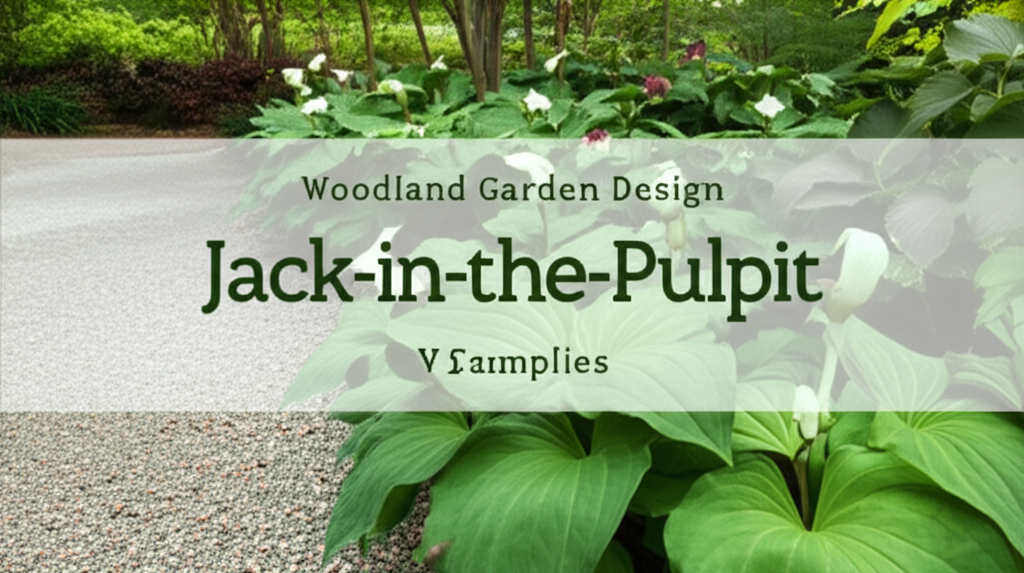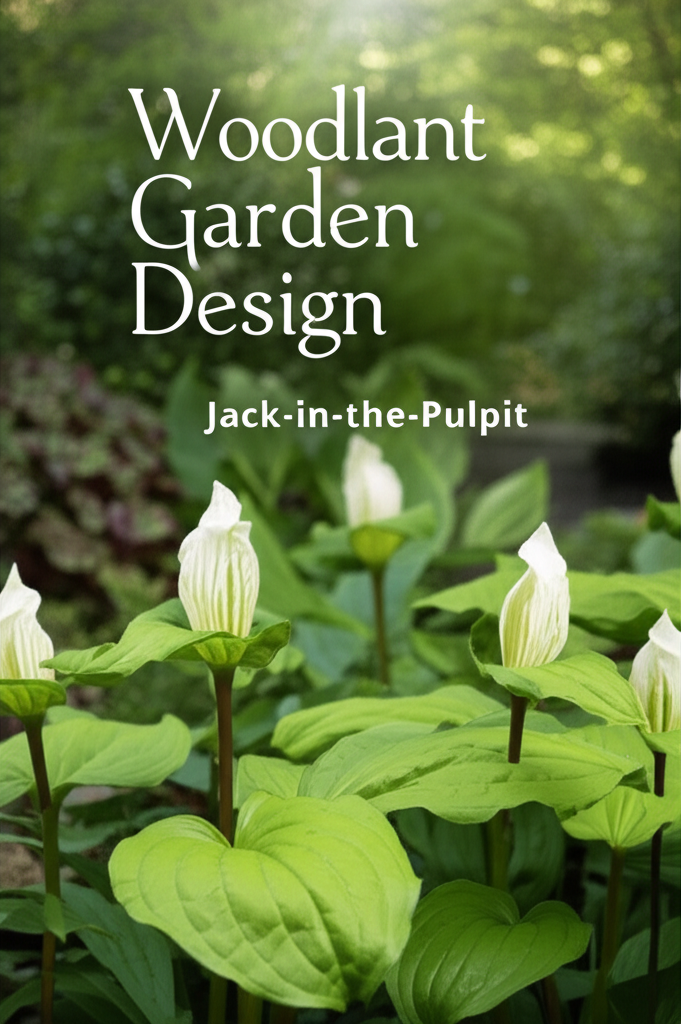The Allure of the Jack-in-the-Pulpit
The Jack-in-the-Pulpit (Arisaema triphyllum) is a quintessential native wildflower that embodies the mystique and beauty of North American woodlands. Its unique, hooded spathe and prominent spadix, resembling a preacher in a pulpit, have captivated gardeners for centuries. Beyond its striking appearance, the Jack-in-the-Pulpit is an integral part of woodland ecosystems, providing food and shelter for various wildlife. Incorporating this fascinating plant into a woodland garden design offers a chance to create a captivating and ecologically rich landscape. This article explores various Jack-in-the-Pulpit woodland garden design examples, offering inspiration and practical advice for cultivating its charm.
Understanding Jack-in-the-Pulpit Needs
Before diving into design, understanding the plant’s fundamental requirements is crucial. Jack-in-the-Pulpit thrives in specific conditions that mimic its natural habitat:
- Shade: It prefers dappled shade or partial shade. Deep, dense shade can inhibit flowering, while full sun will scorch its delicate leaves.
- Moisture: Consistently moist, well-drained soil is essential. It can tolerate damp conditions but not waterlogged soil.
- Soil: Rich, organic, and slightly acidic to neutral soil is ideal. Incorporating compost or leaf mold will greatly benefit its growth.
- Dormancy: The plant goes dormant in late summer or fall, meaning its above-ground parts will disappear. This is a natural process and should not be mistaken for a dying plant.
Design Philosophy: Mimicking Nature

The most successful Jack-in-the-Pulpit woodland gardens emulate the natural conditions where these plants flourish. This means prioritizing shade-loving companions, creating a naturalistic flow, and focusing on soil health. The goal is to create a miniature ecosystem where the Jack-in-the-Pulpit feels right at home, allowing it to thrive and reproduce.
Key Elements of a Woodland Garden
A well-designed woodland garden is a tapestry of textures, colors, and forms. For a Jack-in-the-Pulpit focused design, consider these elements:
- Understory Trees: Smaller trees like Serviceberry (Amelanchier spp.), Dogwood (Cornus spp.), or Redbud (Cercis canadensis) provide dappled shade and seasonal interest.
- Shrubs: Native shrubs such as Rhododendron, Azalea, Viburnum, and Elderberry offer structure, color, and habitat.
- Groundcovers: Carpets of native ferns (e.g., Ostrich fern, Lady fern), Wild Ginger (Asarum canadense), and Foamflower (Tiarella cordifolia) create a lush, verdant base.
- Ephemerals: Spring ephemerals like Trillium, Spring Beauty (Claytonia virginica), and Dutchman’s Breeches (Dicentra cucullaria) bloom before the Jack-in-the-Pulpit reaches its full stature, adding early season color.
- Water Features: A small, naturalistic pond, stream, or even a simple birdbath can enhance the woodland atmosphere and provide essential moisture.
- Pathways: Meandering paths made of mulch, gravel, or stepping stones invite exploration and define garden spaces.
Jack-in-the-Pulpit Woodland Garden Design Examples
Let’s explore some specific design concepts that highlight the Jack-in-the-Pulpit:
1. The Deep Shade Haven
This design focuses on creating a cool, damp microclimate ideal for Jack-in-the-Pulpit.
Planting Strategy:
- Dominant Shade: Utilize the shade cast by mature trees or plant new understory trees like Dogwood.
- Moisture Retention: Incorporate plants that love moisture, such as various native ferns (e.g., Athyrium filix-femina, Dryopteris marginalis), Skunk Cabbage (Symplocarpus foetidus) for very wet areas, and Marsh Marigold (Caltha palustris) near water.
- Groundcover Layer: Extensive use of Wild Ginger creates a dense, attractive mat. Foamflower adds delicate white blooms in spring.
- Jack-in-the-Pulpit Placement: Plant in clusters amongst the ferns and Wild Ginger, ensuring they are not overcrowded and have access to consistent moisture.
- Accent Plants: Consider late-blooming asters or goldenrods to add pops of color in late summer or fall, providing contrast to the green foliage.
Visual Appeal:
This design emphasizes lush greens, varying textures of fern fronds, and the unique sculptural forms of Jack-in-the-Pulpit. The dappled light filtering through the canopy creates a sense of mystery and serenity.
2. The Vernal Pool Garden
This design celebrates the ephemeral bloom and plays with the seasonal moisture fluctuations common in woodland settings.
Planting Strategy:
- Near Water: Locate this garden near a natural depression that collects water in spring or a gently flowing stream.
- Spring Ephemerals: A profusion of Trillium, Dutchman’s Breeches, and Bluebells (Mertensia virginica) will create a spectacular spring display.
- Jack-in-the-Pulpit: Planted where the soil remains moist after the spring ephemerals die back.
- Summer Foliage: Tall ferns like Ostrich Fern (Matteuccia struthiopteris) can fill in the space left by ephemerals, maintaining visual interest.
- Moisture-Loving Companions: Cardinal Flower (Lobelia cardinalis) and Great Blue Lobelia (Lobelia siphilitica) add vibrant color in late summer, thriving in consistently moist soil.
Visual Appeal:
This design offers a dynamic visual experience, evolving from a carpet of spring blooms to lush green foliage and finally to late-season color. The interplay of water and plants creates a vibrant, active woodland scene.
3. The Woodland Edge Sanctuary
This design incorporates Jack-in-the-Pulpit into the transition zone between a lawn or open area and a more densely wooded section.
Planting Strategy:
- Partial Shade: This area receives more sun than a deep woodland, but still requires protection from harsh afternoon sun.
- Gradual Transition: Start with lower-growing plants at the edge, such as Wild Geranium (Geranium maculatum) and Creeping Phlox (Phlox subulata), and gradually introduce taller plants like shrubs and ferns towards the shade.
- Jack-in-the-Pulpit: Planted in clumps within the partial shade zone, intermingled with plants that tolerate a bit more light, such as Columbine (Aquilegia canadensis).
- Shrub Layer: Use native shrubs like Forsythia (for early spring color, planted where it can be pruned to avoid becoming too dominant), Elderberry, or Azaleas.
- Pathways: Define the garden with gentle, curving pathways that lead the eye into the wooded area.
Visual Appeal:
This design creates an inviting and accessible woodland feel, blurring the lines between structured garden and wilder nature. It offers a mix of colors and textures that are appealing from a distance and up close.
4. The Shade Garden with Architectural Interest
This design focuses on the structural qualities of the Jack-in-the-Pulpit and its companions to create a sophisticated woodland feel.
Planting Strategy:
- Bold Foliage: Pair Jack-in-the-Pulpit with plants that have striking foliage, such as Hosta varieties with large leaves, Brunnera (Brunnera macrophylla) for its heart-shaped leaves, or large-leaved Astilbe.
- Vertical Elements: Introduce taller plants like various ornamental grasses suitable for shade, or the elegant spires of Foxglove (Digitalis purpurea) (use with caution due to toxicity if children or pets are present).
- Jack-in-the-Pulpit: Positioned to stand out against a backdrop of contrasting foliage. Consider planting them in asymmetrical groupings for a natural yet curated look.
- Stone Accents: Incorporate natural stone elements like boulders, moss-covered rocks, or a small stone sculpture to enhance the architectural feel.
- Texture Contrast: Mix the smooth, broad leaves of Hosta with the delicate fronds of ferns and the upright form of the Jack-in-the-Pulpit.
Visual Appeal:
This design is more formal and structured, with an emphasis on form, texture, and silhouette. The Jack-in-the-Pulpit becomes a focal point, appreciated for its unique shape against a backdrop of diverse foliage.
Key Facts and Considerations for Jack-in-the-Pulpit Gardens
Here’s a quick reference guide for successful Jack-in-the-Pulpit woodland garden design.
| Feature | Jack-in-the-Pulpit Needs | Ideal Companions | Maintenance Level |
|---|---|---|---|
| Sunlight | Dappled shade to partial shade | Ferns, Hostas, Wild Ginger, Trillium, Columbine | Low to Moderate |
| Soil | Moist, well-drained, rich in organic matter, slightly acidic to neutral | Compost, leaf mold, mulch | Moderate (soil amendment) |
| Moisture | Consistently moist, but not waterlogged | Plants that tolerate damp soil, small water features | Moderate (watering, especially during dry spells) |
| Dormancy | Dies back in late summer/fall | Plants that fill in during late summer, fall-blooming perennials | None (natural cycle) |
| Wildlife Value | Provides food (berries) for birds and small mammals, shelter | Native plants attracting pollinators and birds | Low |
Step-by-Step Design and Implementation
Creating your Jack-in-the-Pulpit woodland garden is a rewarding process. Follow these steps to bring your vision to life.
Phase 1: Planning and Site Preparation
- Assess Your Site: Observe the light conditions, soil type, and existing vegetation. Determine the best locations for your Jack-in-the-Pulpit and its companions.
- Sketch Your Design: Draw a rough plan, marking out areas for planting, pathways, and any desired features like seating or water. Consider mature plant sizes.
- Soil Improvement: This is a critical step. Amend the soil generously with compost, well-rotted manure, or leaf mold to improve drainage and fertility. If your soil is heavy clay, consider raised beds or incorporating coarse sand.
- Gather Materials: Source your plants, mulch, pathway materials, and any decorative elements. Prioritize native species for ecological benefits.
Phase 2: Planting and Installation
- Planting Order: Begin by planting larger trees and shrubs first, as they will define the structure of your garden and create shade.
- Install Pathways: Lay out your pathways, ensuring they are wide enough for comfortable passage and lead the eye through the garden.
- Plant Groundcovers and Perennials: Fill in the understory with ferns, wildflowers, and groundcovers. Plant Jack-in-the-Pulpit corms in groups of 3-7 for a naturalistic effect, ensuring they are at the correct depth (typically 3-4 inches deep).
- Mulching: Apply a generous layer of organic mulch (shredded bark, wood chips, or leaf mold) around all plants. This helps retain moisture, suppress weeds, and regulate soil temperature.
Phase 3: Maintenance and Enjoyment
- Watering: Water regularly, especially during dry periods, to keep the soil consistently moist.
- Weeding: Remove weeds promptly, being careful not to disturb the shallow roots of woodland plants.
- Seasonal Cleanup: In fall, allow the foliage of Jack-in-the-Pulpit to die back naturally. Remove dead foliage from other plants as needed.
- Observe and Adapt: Enjoy the evolving beauty of your woodland garden. Observe which plants thrive and adjust your plantings over time as needed.
Pros and Cons of Designing with Jack-in-the-Pulpit
Designing a woodland garden around Jack-in-the-Pulpit offers unique advantages and some considerations to keep in mind.
| Pros | Cons |
|---|---|
| Unique Aesthetic: Its distinctive flower structure is a conversation starter and adds a touch of the unusual. | Specific Needs: Requires precise conditions of shade, moisture, and soil, which may not be readily available in all gardens. |
| Native Appeal: Supports local ecosystems, attracting beneficial insects and wildlife. | Dormancy Period: The plant disappears entirely during late summer and fall, leaving a gap in the visual interest unless well-planned companions are used. |
| Easy to Naturalize: Once established, Jack-in-the-Pulpit can spread naturally through rhizomes and seeds, creating colonies. | Slow to Establish: Corms can take a year or two to fully establish and begin flowering prolifically. |
| Low Maintenance (once established): Requires minimal pruning or deadheading once the garden matures. | Potential Toxicity: The plant contains calcium oxalate crystals and can cause skin irritation or be toxic if ingested. Handle with care and educate children. |
| Ecological Value: Berries are a food source for birds and small mammals, and its presence indicates a healthy woodland environment. | Limited Bloom Time: The iconic “pulpit” stage is relatively short-lived in the spring. |
Conclusion: Cultivating a Woodland Wonderland
Designing a woodland garden with Jack-in-the-Pulpit is an opportunity to create a magical and ecologically sound space. By understanding its needs and embracing a naturalistic design philosophy, you can cultivate a miniature woodland wonderland that captivates the senses and supports the local environment. Whether you opt for a deep shade haven, a vernal pool garden, or a woodland edge sanctuary, the unique charm of the Jack-in-the-Pulpit will undoubtedly become a cherished feature of your landscape. Embrace the process, enjoy the evolution of your garden, and let the enchantment of this native gem transform your outdoor space.


